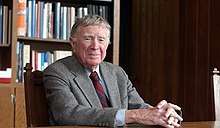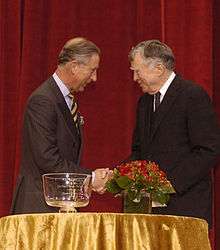Vincent Scully
Vincent Joseph Scully Jr. (August 21, 1920 – November 30, 2017)[1] was an American art historian who was a Sterling Professor of the History of Art in Architecture at Yale University, and the author of several books on the subject. Architect Philip Johnson once described Scully as "the most influential architectural teacher ever."[2] His lectures at Yale were known to attract casual visitors and packed houses, and regularly received standing ovations. He was also the Distinguished Visiting Professor in Architecture at the University of Miami.[3]
Vincent Scully | |
|---|---|
 | |
| Born | August 21, 1920 |
| Died | November 30, 2017 (aged 97) |
| Nationality | American |
| Alma mater | Yale University |
| Occupation | Art historian |
| Employer | Yale University, University of Miami |
| Known for | Architectural teacher |

Biography
Born and raised in New Haven, Connecticut, Scully attended Hillhouse High School. At the age of 16, he entered Yale University. He earned his BA degree from Yale in 1940, his M.A. in 1947, and his Ph.D in 1949. He taught classes at Yale from 1947, often to packed lecture rooms.[4] He was also a Distinguished Visiting Professor at the University of Miami.[5] Scully officially retired from Yale in 1991,[6] but continued giving courses there and at the University of Miami. He announced in 2009, however, at the age of 89, that he was no longer well enough to continue teaching.[7][8]
Scully's early advocacy was critical to the emergence of both Louis I. Kahn and Robert Venturi as important 20th-century architects. Scully was a fierce critic of the 1963 destruction of New York's original Pennsylvania Station, memorably writing of it that, "One entered the city like a god. One scuttles in now like a rat."[9]
Scully died on November 30, 2017 at his home in Lynchburg, Virginia, aged 97. The cause of death was complications of Parkinson's disease.[10]
Awards and honors
In 1952, Scully and his co-author Antoinette Downing won the Alice Davis Hitchcock Award for their book, The Architectural Heritage of Newport.[11]
In 1995, the National Endowment for the Humanities chose Scully to deliver the Jefferson Lecture, the U.S. federal government's highest humanities honor.[12] His lecture was on the topic of "The Architecture of Community,"[13] a concept that became central to his architectural philosophy.[2]
In 1999, the Vincent Scully Prize was established by the National Building Museum to honor individuals who have exhibited exemplary practice, scholarship or criticism in architecture, historic preservation and urban design. Scully himself was the first honoree.[14]
In 2003 the Urban Land Institute awarded Scully its J.C. Nichols Prize for Visionary Urban Development.[15]
In 2004, President George W. Bush presented Scully with the National Medal of Arts, the United States' highest honor for artists and arts patrons.[2][16] The medal citation read: "For his remarkable contributions to the history of design and modern architecture, including his influential teaching as an architectural historian."[17]
Major publications
- American Architecture and Urbanism. Revised Edition. 2013 Trinity University Press
- The Earth, the Temple, and the Gods: Greek Sacred Architecture Revised Edition. 2013 Trinity University Press
- Architecture: The Natural and the Manmade
- The Villas of Palladio
- The Shingle Style: Architectural Theory and Design from Richardson to the Origins of Wright. 1955, Library of Congress catalog card number 55-5988
- Frank Lloyd Wright 1960
- Louis I. Kahn. 1962, George Braziller Inc.
- Modern Architecture - The Architecture of Democracy 1961, 1974
- The Earth, the Temple, and the Gods: Greek Sacred Architecture 1962.
- American Architecture and Urbanism 1969
- The Shingle Style Today 1974
- Pueblo: Mountain, Village, Dance 1989* Modern Architecture and Other Essays 2003
- "An Interview with Vincent Scully by Yehuda Safran and Daniel Sherer," Potlatch 4 (2016).
References
- "National Building Museum". Archived from the original on 2015-03-29. Retrieved 2015-03-07.
- Richard Conniff, "The Patriarch," Archived 2009-05-17 at the Wayback Machine Yale Alumni Magazine, March/April 2008.
- Caves, R. W. (2004). Encyclopedia of the City. Routledge. pp. 586. ISBN 9780415252256.
- Vincent J. Scully at Yale University Department of the History of Art website (retrieved February 6, 2009).
- Vincent Scully at University of Miami School of Architecture website (retrieved February 6, 2009).
- "Mr. Scully's Architecture Class Is Dismissed"
- "With apologies, a legendary lecturer steps down"
- "Professor Vincent Scully Retires"
- Herbert Muschamp, "Architecture View; In This Dream Station Future and Past Collide," The New York Times, June 20, 1993.
- Richard B. Woodward, "Vincent Scully, 97, Influential Architecture Historian", The New York Times, December 1, 2017.
- Alice Davis Hitchcock Book Award Winner History at Society of Architectural Historians website (retrieved February 6, 2009).
- James Barron, "Chronicle," New York Times, May 15, 1995.
- Jefferson Lecturers at NEH Website (retrieved February 6, 2009),
- Vincent Scully Prize Archived 2009-02-14 at the Wayback Machine at National Building Museum website (retrieved February 6, 2009).
- "Scully honored for shaping the vision of urban planners," Yale Bulletin & Calendar, September 26, 2003 (retrieved February 6, 2009).
- "Scully is awarded National Medal of Arts at White House ceremony," Yale Bulletin & Calendar, December 3, 2004 (retrieved February 6, 2009).
- "2004 National Medal of Arts: Vincent Scully" at National Endowment for the Arts website (retrieved February 6, 2009).
External links

- Vincent Joseph Scully Writings (MS 1872). Manuscripts and Archives, Yale University Library.